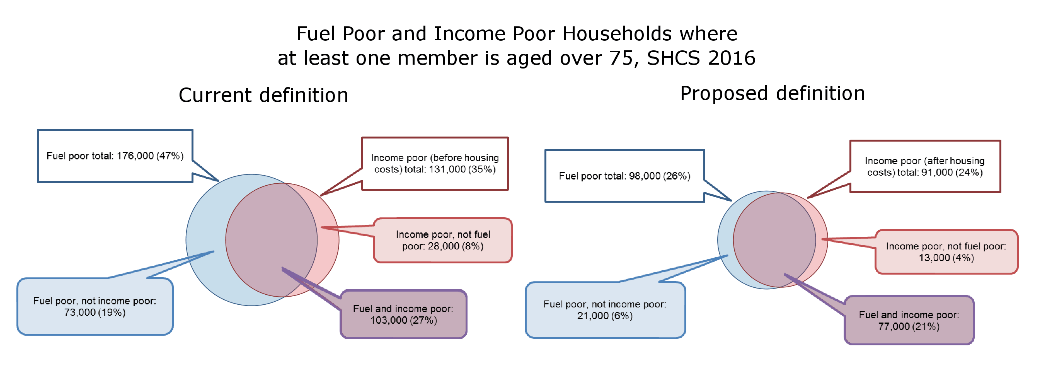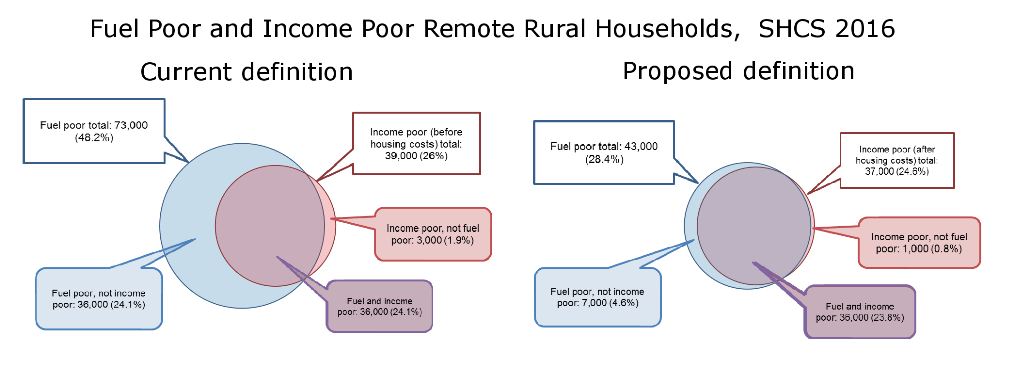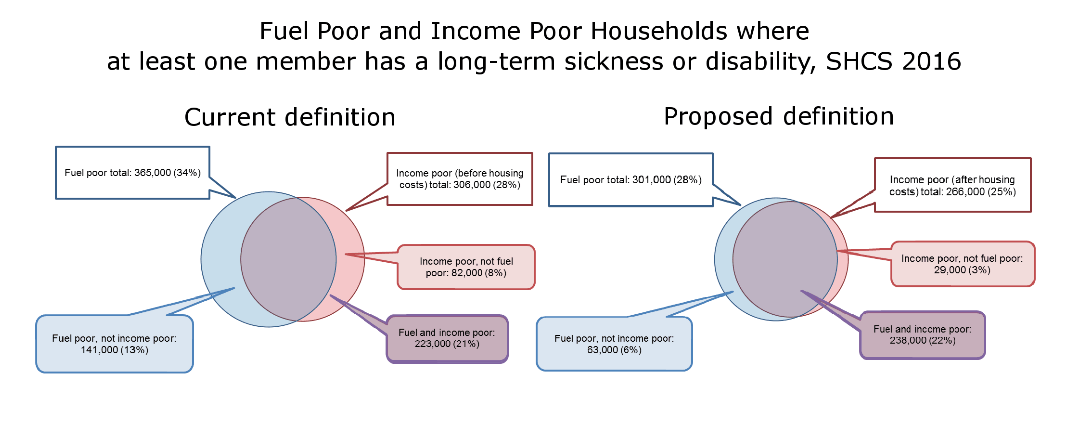Draft Fuel Poverty Strategy for Scotland 2018
The draft fuel poverty strategy sets out the policy development of the Fuel Poverty (Target, Definition and Strategy)(Scotland) Bill and the draft Fuel Poverty Strategy for Scotland 2018.
Technical Annex
Fuel Poverty measurement
National measurement of fuel poverty will continue to be through the annual Scottish House Condition Survey ( SHCS). The SHCS is a nationally representative survey of Scottish households with a sample size of around 3,000 households per year. The design of the survey is such that it provides robust National Statistics on fuel poverty at a Scotland level annually and at a local authority level by combining 3 years’ worth of data. The outputs of the survey include modelled required energy consumption and fuel costs for each household to achieve the recommended heating regime based on information available about the dwelling and household characteristics as well temperature, solar radiation and wind speed in the regional location of the property. This data, along with survey information about household income, housing and childcare costs, can be used to determine whether the household is fuel poor, along with the corresponding depth or fuel poverty gap.
The fuel poverty definition
The first Fuel Poverty Statement, that was published by the Scottish Executive in 2002 under section 88 of the Housing (Scotland) Act 2001, set out a definition of fuel poverty, i.e. that a household was fuel poor if energy costs to keep their home sufficiently warm were not less than 10% of their income (informally known as the '10% definition').
As highlighted by the independent definition review panel [14] , section 95 of the Act indicated that ‘a person lives in fuel poverty if that person is a member of a household with a low income living in a home which cannot be kept warm at a reasonable cost’. However the subsequent Statement made no reference to income levels in setting the definition.
This has been addressed in the new definition of fuel poverty being put forward under the Fuel Poverty (Target, Definition and Strategy) (Scotland) Bill.
Underpinning the overarching definition, there are four key areas where we want to provide additional explanation about how we will measure the number of households experiencing fuel poverty.
1. An income threshold
The definition will focus in on low income households by introducing a new income threshold which will be 90% of the UK Minimum Income Standard ( MIS) after the MIS costs for fuel, rent, council tax, water rates and childcare are deducted.
This removes higher income households from the Fuel Poverty definition, even if they would need to spend 10% or more of household income on required fuel costs. This threshold is also considerably higher, for most household types, than the standard 60% of median income (after housing costs) used to define relative income poverty which ensures households above the income poverty line, that are struggling with their bills, will be captured in the definition.
2. Required fuel costs to income ratio
The 10% fuel cost to income ratio will move from Before Housing Costs ( BHC) to be based on an After Housing Costs ( AHC) basis. This is a much broader definition than we have had previously and will capture many more households struggling to afford required fuel costs once they have paid their rent or mortgage.
3. Heating regimes
In the Bill we have set out the temperature regimes that will be applied under this new definition to contribute to a healthy, indoor living environment which is free from condensation, mould growth and damp. They are relevant throughout the whole year although the required energy to meet them will vary, including according to monthly average external temperatures for the region in which the household lives.
The new heating regime represents an enhancement from the current definition of fuel poverty for households that we anticipate to be most affected by the adverse outcomes of living in a colder home. For these households, the other rooms’ temperature in the heating regime for the new definition increases from 18°C to 20°C compared to the 10% definition while the living room temperature is maintained at 23°C. This removes the potentially harmful impact of a 5°C temperature difference between different rooms in the home.
We will define in regulations to the Bill, the households to which the enhanced heating regime will apply. This is likely to cover those households where:
a) at least one member has self-reported as having a physical or mental health condition or illness lasting or expected to last 12 months or more;
b) or, in the absence of the above, at least one member is aged 75 or over.
Part a) is the same criteria as used in the 10% definition. Using self-reported information gathered through the SHCS we are identifying households where members themselves report that they have a condition which may impact on their needs in the home, although we do not ask them to tell us how their condition affects them.
It would be very challenging to define a list of long-term illnesses or disabilities that would indicate a person requires an enhanced heating regime because some medical conditions and disabilities can affect people differently and that means we generally wouldn’t categorise individuals with any specific medical condition or disability as making a person ‘vulnerable’. Depending on the medical condition or disability, different people might have very different functional ability with some needing a lot of assistance for daily living whilst others may be fully independent, and this can mean they can have different fuel requirements. However, we propose to undertake some additional work to determine whether it is possible to refine part a) further in order to better capture those who are likely to be most affected by the adverse outcomes of living in a colder home.
Part b) represents a change from the 10% definition. More older people than ever before are living healthy, active independent lives, well into their retirement. Therefore, we believe that an enhanced heating regime for all older people once they reach 60 years of age is no longer appropriate and, as we set out in our consultation, we will increase the age thresholds at which older households are considered to require an enhanced heating regime, based on age alone. The independent panel that reviewed the fuel poverty definition, suggested that a threshold around 75 – 80 years of age may be more appropriate and we have decided to use the lower age of this range so that, for older households, where a person does not suffer from any long-term ill health or disability, we will not consider them as needing this enhanced heating regime until they reach 75 years of age.
This age threshold is also consistent with our approach to our Warmer Homes Scotland fuel poverty scheme. Eligibility criteria for that scheme was agreed with input from key stakeholders, including Age Scotland and Citizens Advice Scotland, to ensure support is focussed on those with low incomes, including the working poor, fuel poor families, plus those aged over 75.
Our analysis of 2015 data indicates that 60% of households with any adults aged between 60 and 74 inclusive will still be classed as needing this enhanced heating regime because of health issues or because they also contain another adult aged 75 or over. Overall, based on the likely definition described above, our current modelling indicates that around 80% of households classified as needing an enhanced heating regime under the existing definition will remain so under the new definition. The following chart demonstrates that the improved targeting of the new definition also applies to those households where at least one member is aged 75 or over.

If any additional medical evidence is brought forward in the future that indicates a different age threshold is more appropriate then we will review this aspect of the definition.
4. Enhancements to the Minimum Income Standard ( MIS)
We do not intend to include a specific remote rural enhancement to the new MIS income threshold and we will not include a specific enhancement to the new MIS income threshold for households with members with a long-term illness or disability.
In the interests of transparency and robustness it is important that we maintain consistency with approaches to support the real living wage, where the UK MIS with no additional income enhancements is used. We also describe below the ways in which needs of these households are already taken into account in the measurement of fuel poverty.
For remote rural households, the way fuel poverty is calculated already takes account of regional variations in external temperatures, solar irradiance and exposure to the wind as well as types of stock and information about occupants. These can lead to greater energy usage estimates to maintain either standard or vulnerable heating regimes in rural and remote rural areas. In addition, regionalised (North and South Scotland) energy prices are used in the fuel poverty calculation (for mains gas and electricity).

The enhanced heating regime is likely to be applied to many households where a member has a long-term sickness or disability. This results in higher required fuel costs for these households than those for which the standard regime is applied. The required fuel costs for these households will also be higher than under the current definition since the other room temperature for the enhanced heating regime has been increased. These higher fuel costs are both compared to After Housing Cost income and subtracted from household income before the residual is compared to the MIS threshold meaning that, all other things being equal, such households are more likely to be identified as fuel poor.

Worked Examples
It can be challenging to visualise what a fuel poor household might look like under this new definition. In order to help demonstrate that, we have developed two worked examples which are set out on the following page:
Example 1: A couple with no children living in a home which has an EPC energy efficiency rating of E. The couple’s total net income (including income from employment and benefits with council tax, water and sewerage charges deducted) is £20,000 and they pay £5,500 in rent each year. Their annual income after housing costs is therefore £14,500. One member of the couple has a long-term sickness or disability and therefore spends longer in the home requiring heating. This couple is not considered income poor because £14,500 is above 60% median income after housing costs (£13,300 for this household type in 2016/17). However, they would be considered fuel poor under our new definition because their fuel bills are around £2,600 per year leaving a residual income of £11,900 which is below 90% of the relevant MIS threshold (2016) after council tax, water, rent, fuel and childcare costs (£13,348).
Example 2: A single parent with two children, one aged 3 and the other aged 7 living in a home with an EPC energy efficiency rating of C and relying on grandparents to provide childcare. The total net income for the household (including income from employment and benefits with council tax, water and sewerage charges deducted) is £15,000 and they pay £5,000 in rent each year. Their annual income after housing costs is therefore £10,000, below 60% median income for their household type and therefore the family is income poor. Fuel bills for the family are £1400 per year leaving a residual income of £8,600 which is below the 90% MIS threshold of £15,350 fo this household type.
Fuel Poverty and Income Poverty
Data is presented in this Draft Strategy compares fuel poverty and income poverty under the current definition with that for the new definition. Under the current definition, net income is calculated before housing costs whereas under the new definition it is calculated after housing costs. This means that different relative poverty thresholds are applied. The relative poverty threshold (60% median income) for a couple with no children before housing costs for 2016/17 is £15,400 and after housing costs is £13,300. The relative poverty thresholds for other household types are calculated from this data by applying appropriate equivalisation scales. It is possible to use the SHCS to determine how fuel poverty and income poverty relate, although there are some caveats meaning the results presented here are approximate and do not reproduce exactly the official measure of income poverty. The diagram for the current definition is different to previously published information as council tax has been deducted from BHC income in line with established income poverty methodology.
Future Developments
Data presented for the proposed new definition, is our best available estimate based on the 2016 SHCS. Further work is in progress to collect information through the 2018 SHCS on the income of other adults (beyond the highest income householder and their spouse) in the household as well as childcare costs. These are not currently accounted for in the data presented. We will also be undertaking analysis of missing survey housing cost data, determining households to which the enhanced heating regime should apply, employing the full 107 MIS thresholds and considering smoothing of the MIS data over time if required.
Contact
There is a problem
Thanks for your feedback